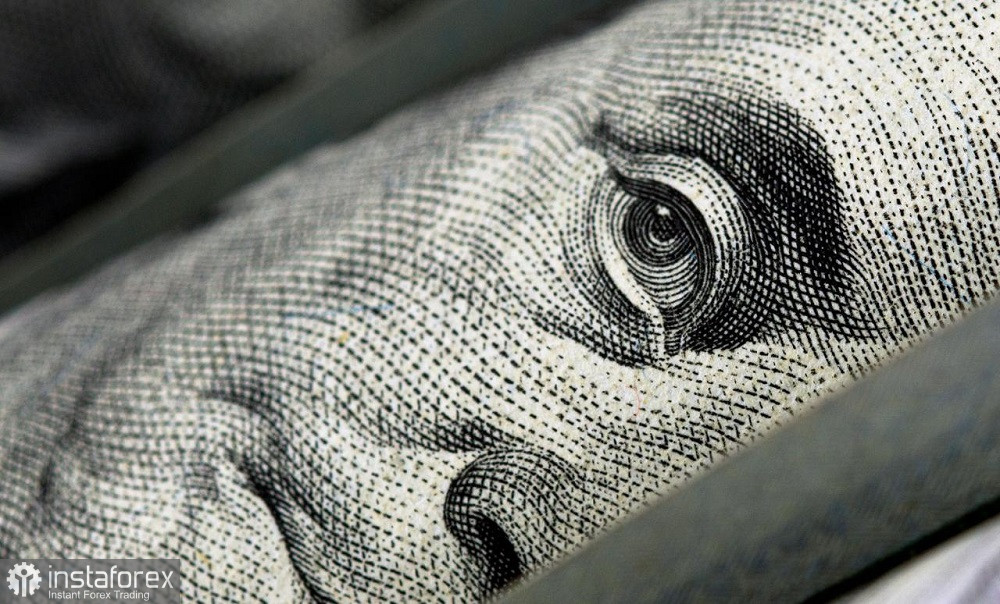The euro-dollar pair updated its seven-week price low the day before yesterday, marking at 1.0725. However, EUR/USD bears didn't dare to storm the 1.06 mark and locked in profits. Buyers took over the initiative on the pair, initially demonstrating modest results (the pair remained within the 1.07 figure) but then surged upward. At the moment, the price is testing the resistance level at 1.0850 (the middle line of the Bollinger Bands indicator, coinciding with the Tenkan-sen line on the daily chart).

Such price dynamics look illogical, to put it mildly. However, there is indeed a formal reason for the dollar's weakening – business activity in the U.S. services sector unexpectedly slowed in March, contrary to opposing forecasts. But one release cannot break the trend, especially since almost all other fundamental factors are either in favor of the greenback or against the euro. Therefore, such a confident price increase raises many questions. And frankly, it raises mistrust, considering the news flow of recent days.
Speaking of macroeconomic reports, indeed, according to the data published yesterday, the ISM non-manufacturing index fell to 51.4 instead of the forecasted rise to 52.8 points. On one hand, the report came out in the red zone (and here, the negative reaction of the dollar is quite justified), but on the other hand, the indicator remains in the expansion zone, meaning it is above the key 50-point mark. The subindex of prices paid decreased to 53.4 points. There is a downward trend (January – 64 points, February – 58.6), indicating deflationary tendencies in this sector.
It is necessary to remind that the ISM manufacturing index published on Monday for the first time since October 2022 was in the expansion zone (50.3 points), contrary to forecasts of a decrease to 48.5 points (the employment index increased to 47.4, from the previous value of 45.9). Additionally, the volume of orders for products manufactured in the U.S. increased by 1.4% in February, while most experts predicted growth of 1.0% (and in the previous month, this indicator fell by 3.8%).
JOLTS data also favored the dollar: the number of job openings increased to 8.756 million (previous value – 8.748 million), while the market expected this indicator to be at 8.74 million. Moreover, the ADP report published yesterday, two days before the March Nonfarm Payrolls, also had a green hue. According to this report, the number of jobs in the private sector increased by 184,000 in March (with a forecast of 148,000). This is a strong signal indicating that official labor market data may also please the dollar bulls.
As we can see, the macroeconomic reports published this week, for the most part, demonstrated positive dynamics. The notorious U.S. services sector activity index also remained in the expansion zone. The core PCE index, published last Friday, indeed decreased, reaching the forecasted level of 2.8%. However, the overall PCE accelerated for the first time since September.
Comments from Federal Reserve representatives also do not contribute to the weakening of the American currency. For example, yesterday, Federal Reserve Chair Jerome Powell stated that the central bank's fight against inflation "has not ended yet." At the same time, he emphasized that the regulator intends to lower the interest rate once it gains confidence that inflation is steadily declining to the target two percent level. However, Powell noted that it is still too early to conclude inflation acceleration – February reports may indicate short-term jumps ("potholes," as the Fed chairman previously expressed it). In any case, according to Powell, the Federal Reserve will make decisions on rates "from meeting to meeting" – there is no predetermined trajectory of reduction.
A few days before Powell's speech, Atlanta Federal Reserve President Raphael Bostic, who has voting rights this year, stated that he expects only one interest rate cut this year. According to him, inflation is decreasing more slowly than expected, and excessive price increases have been recorded for many goods.
Federal Reserve Bank of Cleveland President Loretta Mester, also with voting rights this year, urged not to rush with monetary policy easing the day before yesterday. According to her, too early (as well as too rapid) reduction of the interest rate "risks nullifying the progress the central bank has made in terms of inflation." A similar position was voiced by Board of Governors member Christopher Waller.
In such circumstances, can we talk about a sustained decline in the U.S. dollar index of a fundamental nature? And, consequently, about a sustained rise in the EUR/USD pair? Especially considering that the data published this week reflected a slowdown in inflation both in Germany and in the eurozone as a whole.
In my opinion, the current price increase is too emotional and, for the most part, unjustified. A weaker services sector activity index (which, I repeat, remained above the 50-point mark) is not a reason to break the trend, especially against the backdrop of "moderately hawkish" Fed comments, strong labor and production market reports, and a slowdown in inflation in the European region.
Therefore, considering the rather strange situation that has arisen on the pair, it is now advisable to take a wait-and-see position. The upward impulse of EUR/USD is like a "castle on sand" or, if you will, a house of cards without a solid foundation.
 English
English 
 Русский
Русский Bahasa Indonesia
Bahasa Indonesia Bahasa Malay
Bahasa Malay ไทย
ไทย Español
Español Deutsch
Deutsch Български
Български Français
Français Tiếng Việt
Tiếng Việt 中文
中文 বাংলা
বাংলা हिन्दी
हिन्दी Čeština
Čeština Українська
Українська Română
Română

